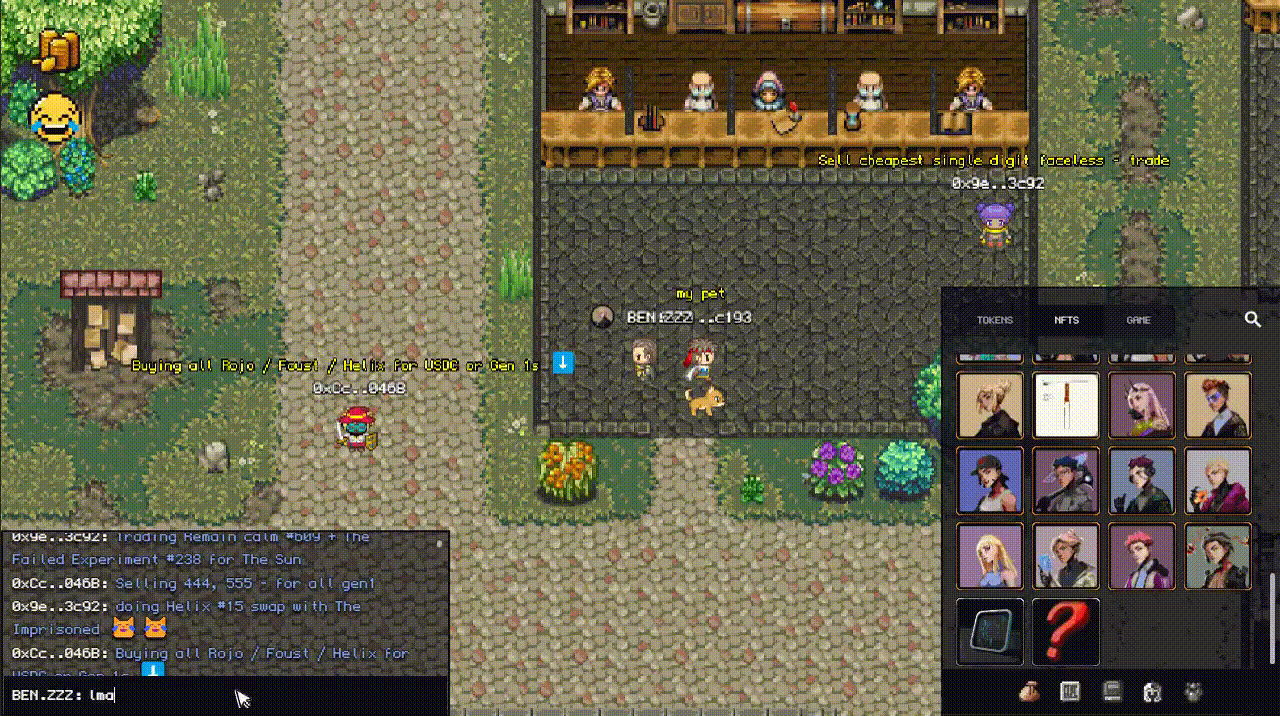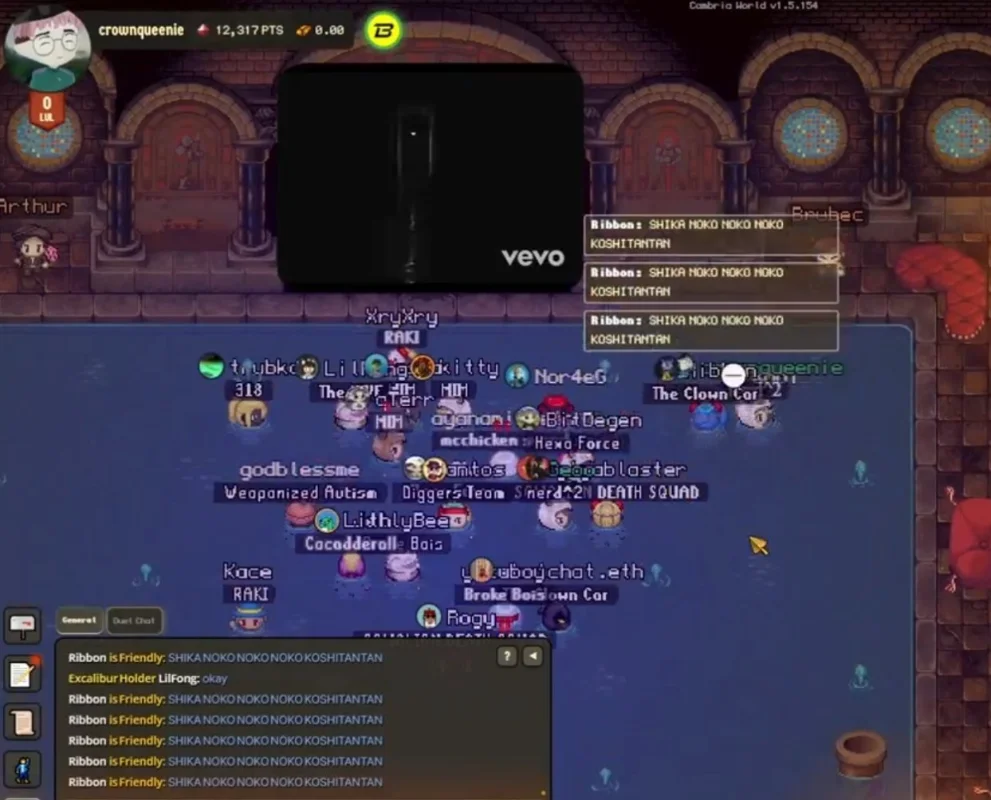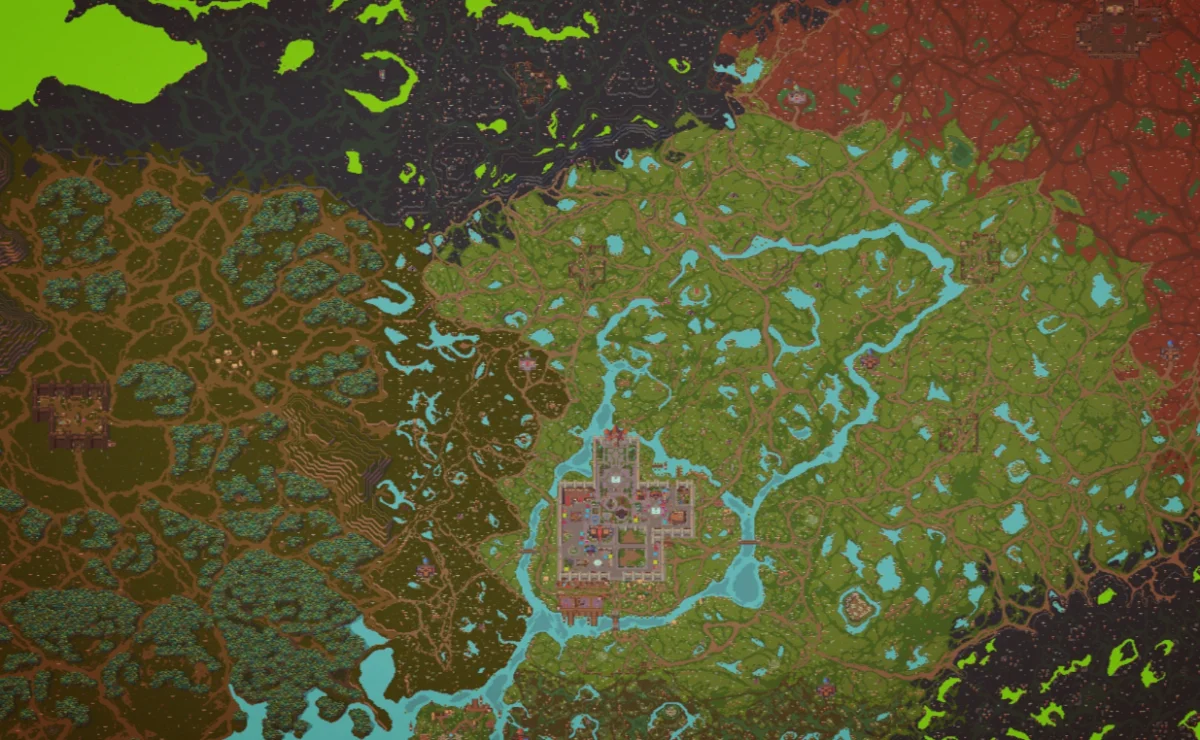How did Cambria begin?
Degen Arena is the 1v1 duel mode of the MMORPG Cambria, a blockchain game inspired by classics like RuneScape and Ultima Online. The project was conceived in late 2022 by a team led by Ben.zzz, its founder. The team identified an enthusiastic community of degens nostalgic for RuneScape and set out to build a crypto-native MMO from scratch.
Throughout 2023, they developed a custom browser-based game engine capable of fully synchronizing on-chain game state and scaling to hundreds of thousands of players in a persistent world. This technical approach-making the blockchain a core component of the game’s architecture, was risky, but it laid the foundation for Cambria risk-reward proposition.
In its early days, Cambria launched Duel Arena as a prototype minigame to test the core PvP and on-chain economy. The first version was released in 2023 on the Base in a private alpha, receiving overwhelming reception: players wagered $14 million in ETH during that initial test. This early success demonstrated the viability of the concept and motivated the project expansion.
In early 2024, the team migrated Duel Arena from Base to Blast. Cambria also secured funding: in July 2024, it announced a $2.5 million seed round led by 1kx and BITKRAFT Ventures, with participation from members of Delphi Ventures, Backed and other notable crypto investors. With this backing and after roughly two years of development, Cambria prepared to launch its full MMO and an enhanced Duel Arena

How were Duel Arena, Gold Rush, and their NFTs?
Duel Arena offers high-stakes 1v1 PvP combat within the Cambria universe. Two players face off in a public arena where each duel is literally “life or death”: the winner takes the entire wager and the loser loses it all. Before the fight, opponents negotiate the terms of the duel, including the duel type, which defines the allowed weapons and combat conditions. For example, they can agree to a giant-axe duel for a straightforward brute-force battle, or an advanced duel with a whip and dragon-steel dagger, which requires greater technique and speed. During the match, players must switch between three combat stances—accurate, aggressive, and defensive, which affect their accuracy and damage. Some modes also allow special attacks, adding an extra strategic layer to combat. A players ability to adapt their strategy based on chosen weapons and stances is key to mastering this combat system, which is deceptively simple but highly competitive.
- The Duel Arena interface is entirely browser-based. Thanks to its custom graphics engine, the game delivers retro-medieval 2D/3D visuals and runs smoothly on various devices with minimal loading times.
Gold Rush is the game MMO mode. Similar to RuneScape, progression depends on leveling up your skills, allowing you to access more valuable resources, better tools and advanced magical abilities. Your goal is to reach the maximum level to explore new regions, face stronger enemies and compete against other players. The main challenge is energy management. Zones are divided into tiers (e.g., T2 to T5) and the higher the tier, the more energy they consume. In return, they also offer increased chances of obtaining valuable items and “trinkets.” The rarer a trinket is, the more points it contributes toward the airdrop. However, it’s not all that simple: high-level zones can affect your sanity or increase your stress, making you more vulnerable to attacks, lowering your defensive capabilities, and triggering various negative effects. Even so, staying longer in these areas significantly increases your chances of obtaining major drops. The world is vast, featuring multiple cities, each with its own independent markets, offering unique trade routes and economic dynamics.
Cores: they are the engine behind the companion and aspect markets. Cores generate fragments, which are essential for their holders. What are they used for? These fragments are used to craft companions and aspects, which can then be used in-game or sold on secondary markets. Additionally, aspect fragments can also be burned to access a portion of Duel Arena AT (Arena Tokens), adding another layer of utility and economic incentives for players.
Islands: they function as micronations for their owners. Each owner establishes their laws, taxes, and citizenship system. "Citizens", known as settlers, work on the island and pay taxes to the lord or lady while respecting local rules. To settle there, settlers must pay an initial tax, and as long as they work, they continue contributing to the internal economy. T2 islands and above can operate as guild bases, and the resources produced there can be shipped to the mainland. However, there is a risk: shipments can be raided by pirates or players, adding a strategic layer to commerce. The owner, settlers, guilds and any interested participants share responsibility for growing the local economy, strengthening activities, protecting the territory, and maintaining the island in good condition, as it can deteriorate. All of this is key to ensuring its survival and prosperity within the world of Cambria.
Founder NFT collection, which represents symbols of power within the game’s lore (the Staff, the Scroll, the Falcon, etc.). These NFTs grant unique advantages such as noble titles, reduced Arena fees, exclusive social areas in the world, and even future airdrops. Beyond being collectibles, these Founder NFTs function as a perpetual battle pass: they guarantee early access to all future modes and reward loyalty with increasing benefits

The Community
The Duel Arena and Cambria community is one of its foundational pillars. Unlike many projects where the community plays a passive role, here players have been involved since the earliest stages. Before public releases, the team carried out multiple closed playtests with members of their Discord, during which players shared feedback and, surprisingly, risked real money even in the initial phases. In a pre-alpha test, users invested $39,000 in ETH over a single weekend in a “very early and ugly” version of the game, driven solely by the excitement of competing and helping improve the product.
This level of commitment from the pre-alpha phase led to the formation of a loyal player base that deeply identifies with the project. Cambria rewarded many of these pioneers with special statuses (such as the Architect role for 2022 testers, free NFTs, etc.), which established a culture of passionate early adoption that remains essential to its growth.
Although in November 2025 the server (Discord) was hacked in an attempt by bad actors to steal from its members, the attack was blocked almost instantly and the server was recovered

The Economy
The economy of Cambria Gold Rush and Duel Arena is defined by the principle that “the wager is the reward.” Unlike games where currency is printed for players to use, in Cambria value flows to and from the players themselves, mediated by smart contracts. Even so, the ecosystem includes several types of tokens and internal currencies: ETH Wagers: Duels are carried out by wagering ETH on compatible L2 networks. Initially, ETH was wagered on Base; later on Blast, then on RON and again on Abstract.
-
Arena Token: Within the game, there is a currency often called Arena Tokens, which is earned by playing. This token is used as currency for purchases and rewards. For example, players can spend Arena Tokens on chests, emotes, cosmetic skins, and other collectibles in the Arena Shop. Although these tokens did not originally exist as NFTs or ERC-20 tokens, the team plans to tokenize some of them (especially purchased items) as NFT/FT in the future, allowing players to freely trade rare items obtained with Arena Tokens. Notably, the developers do not sell Arena Tokens directly; they are earned by playing or wagering, which prevents external inflationary pressure on the economy. During Gold Rush Season 1, an interesting dynamic emerged: 366,000 Blast Gold (~$100,000) was distributed among the top players as rewards, which could then be converted into real value.
-
ETH (Prize Pools): In competitive seasons, the main reward is paid in ETH. Cambria adopted ETH for its Main Prize Pool in Season 2, ensuring that the top rewards have real, widely recognized value outside the game. The ETH pool is indirectly funded by player contributions, as players spend ETH/RON on Charters and consumables. At the end of the season, the dApp calculates player metrics and distributes the ETH, pool according to leaderboard rankings. This model is smart: player spending becomes the engine that funds rewards, aligning incentives (the more players invest in playing, the larger the total prize for the top competitors). In Season 2, as mentioned, over $1 million was raised in just days, all funded by the community, and redistributed among the most skilled players. It is a nearly self-sustaining circular economy. In current Duel Arena events and raffles, everything continues to be paid in ETH (e.g., $10K USDC in Faerie Gacha).
-
NFTs and Collectibles: The Founder NFTs were sold/issued in September 2024; some were free for early testers, others priced at 0.05–0.1 ETH. This not only helped partially fund development but also aligned incentives with the community. In Season 1, top-tier rewards included raffle tickets for land and pets, hinting at Cambria future land and pet market traditional MMO staples likely to become new economic pillars. Meanwhile, Islands have a model dependent on their national settlers. They pay taxes, an entry fee to settle on the island, and contribute to an island maintenance treasury. They will also have benefits in Duel Arena and Gold Rush, as well as airdrop/point boosts.
-
Additionally, Cambria integrated FriendTech keys long ago as wagerable assets in Duel Arena, a nod to liquidity across other Web3 protocols. If a player wishes, they can wager their FriendTech key (an NFT representing social shares) in a duel. This demonstrates Cambria extreme flexibility in handling any ERC-20 or ERC-721 as wagerable value. This level of economic interoperability is unique, turning Duel Arena and Cambria as an MMO into a practically universal barter-and-wager platform within a game. This is not currently available, but it may be adapted again in the future

Performance Results
Overall, Duel Arena and Cambria have shown impressive results in their early years. In terms of adoption, the official website reports more than 128,000 registered accounts by mid-2025. Player activity has been strong: by the end of 2024, more than 1.5 million duels had been fought, handling a cumulative wager volume of over $100 million, all fully on-chain. In the first three months following the migration to the Blast network (early 2024), players completed around 700,000 matches, wagering more than $88 million in ETH and generating $1.3 million in fees for the ecosystem. These figures positioned Duel Arena as one of the leading Web3 gaming dApps in terms of transaction volume during that period.
For Season 2 (April 2025), the figures increased even further: in less than a week, players funded more than $1,000,000 USD into the prize pool by purchasing around 21k Royal Charters (passes) and 132k Energy Orbs to participate. It is important to note that this prize pool is player-funded, meaning it comes directly from participants purchasing the items required to play an innovative model where the community funds its own rewards. At the end of the season, Cambria distributed the prize in ETH to players based on their performance (measured primarily by Coins earned, resulting from converting in-game loot). The results of Season 2 solidified the internal economy: 15k active players competing fiercely in both PvE and PvP, demonstrating that a Web3 game can reach engagement and revenue levels comparable to traditional e-sports events.
As for Duel Arena, its new version greatly improved upon the initial release by adding more content, weekly surprises, raffles, and rewards. At the current price of ETH, $33M have been wagered. Fees earned have been distributed across Excalibur, creators, event raffles, and more. The current success of DA is enormous

Detailed Cambria timeline:
-
September 2022 – Origin: The initial idea for Cambria emerged after a viral tweet; development of the proprietary game engine began.
-
Mid-2023 – Alpha on Base: Duel Arena debuted in a private alpha on Base; players wagered around $14 million in duels during this phase.
-
Early 2024 – “Blast” Season: Migration to the Blast network. In just about 3 months, more than 700,000 duels were recorded on Blast, with wagers exceeding $88 million in ETH, all managed fully on-chain. These duels generated over $1.3 million in fees for the Cambria ecosystem.
-
July 2024 – Funding: Cambria closed a $2.5 million seed round led by BITKRAFT and 1kx, aimed at developing the risk-reward MMO inspired by RuneScape.
-
September 2024 – Founder NFTs: Cambria’s Founder NFT collection launched on Ethereum, granting special benefits to early supporters (titles, reduced fees, etc.) and forming the core of the founding community.
-
October 2024 – Early Gold Rush Alpha: The first alpha of the MMO game, Gold Rush, began for 2 days, with thousands of players testing Cambria’s full vision on regional servers.
-
November 2024 – Season 1: Launch of Season 1: Gold Fever simultaneously on the Ronin and Blast networks, with a competitive event from November 20–24. A $1,000,000 USD P2A prize pool was distributed among the top participants.
-
February 2025 – Expansion to Abstract: Cambria announced its expansion to Abstract Chain to improve scalability and reduce game costs.
-
April 2025 – Season 2: Launch of Season 2: “The Payers” on Abstract + Ronin. In just 6 days, thanks to the participation of 8,862 players (who purchased approximately 21,877 Charters and over 132,000 Energy Orbs), the player-funded prize pool surpassed 1 million USD. The season introduced new economic mechanics (Payer vs. Viceroy roles) and mid-season PvE events, solidifying Cambria’s status as a pioneer of high-stakes gameplay.
-
August 2025 – Launch of the new Duel Arena with tons of content, wagering, pre-TGE, Excalibur boosts, and aspect boxes. To date, it remains the mode that has stayed online the longest since launch, moving over $35M in volume.
-
October 2025 – Launch of Cambria second most important collection: Islands. 3,333 NFTs that grant the title of lord/lady, enable player migrations to the islands as settlers to seek jobs and opportunities while paying taxes. The mint sold out in 3 minutes and 8 seconds, adding an additional $2 million USD funding round led by BITKRAFT Ventures and Sky Mavis

3
0
NEWSLETTER
Subscribe!
And find out the latest news
Other news you might be interested in
Etiquetas






